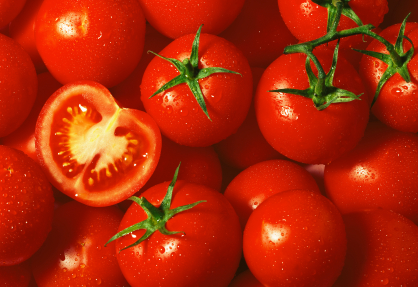 Introduction:
Introduction:
Lycopene is a red pigment of the carotene class of compounds that is found in tomatoes and other red fruits and vegetables. It has received a lot of attention because it is extremely protective against heart disease and the major cancers (i.e., breast, colon, lung, skin, and prostate cancer).
In addition to being available through dietary sources, lycopene is a popular dietary supplement. A new study from Ohio State highlights impact that dietary lycopene can have on blood and prostate levels in men. The results are quite interesting.
Background Data:
Lycopene has shown benefits in improving prostate health and protecting against the development of prostate cancer. In one of the more detailed studies, Harvard researchers discovered that men who consumed the highest levels of lycopene (6.5 mg per day) in their diet showed a 21 percent decreased risk of prostate cancer compared with those eating the lowest levels. Men who ate two or more servings of tomato sauce each week were 23% less likely to develop prostate cancer during the 22 years of the study than men who ate less than one serving of tomato sauce each month.
Lycopene consumption also has been shown to lower the risk of heart disease, cataracts, and macular degeneration. For example, population based studies have shown consumption of more than 7 servings per week of tomato-based products is associated with a 30% reduction in the relative risk of heart disease.
Much of the benefits of tomatoes and lycopene are thought to be due to their ability to fight inflammation, especially in obesity. In obesity the increased level of body fat leads to an increase in circulating inflammatory mediators. Since lycopene has been shown to reduce markers of inflammation, researchers have hypothesized that the consumption of tomatoes and other lycopene-rich foods may help to reduce inflammation in people who are overweight or obese.
Even something as simple as drinking a glass of tomato juice may produce anti-inflammatory benefits. In one double-blind study, groups overweight and obese women were given either 330 ml/day of tomato juice or water for 20 days. At baseline and day 20, serum concentrations of inflammatory mediators were compared between the groups. The results showed that tomato juice reduced the presence of important compounds linked to inflammation and as a result it is thought that frequent consumption may help in reducing the risk of developing chronic diseases linked to inflammation such as heart disease, cancer, and diabetes.
The absorption of lycopene is highly dependent on the tomato product being consumed. The redder the tomato, the higher the lycopene content and the more the tomato is processed, the better the lycopene is absorbed because processing “liberates” more lycopene from the plant’s cells. The absorption of lycopene is five times greater from a supplement, or tomato paste or juice than from raw tomatoes. Eating a lycopene source with oil, such as olive oil, can also improve its absorption. That’s another reason why a Mediterranean diet has so many healthful properties.
New Data:
To determine the effect of typical servings of commercially available tomato products on blood and prostate lycopene concentrations, men scheduled to undergo removal of their prostate glands due to cancer were randomized either to a lycopene-restricted control group ( < 5 mg lycopene/d) or to groups providing 25-35 mg lycopene/day from the following tomato products: tomato soup (2-2¾ cups prepared/day); tomato sauce (5-7 ounces/day); or vegetable juice (11-16.5 fluid ounces/day).
Tomato soup, sauce and juice consumption significantly increased plasma lycopene concentration from 66%, 71%, and 59%, respectively, while the controls consuming the lycopene-restricted diet showed a decline in plasma lycopene concentration by 24%. The end-of-study prostate lycopene concentration was was 3.5-, 3.6-, and 2.2-fold higher in the tomato soup, sauce, and juice consumers, respectively.
Interestingly, in the tomato products, 80-90% of the lycopene is in the trans (linear) configuration, while in the blood and prostate isomers 47% and 80 %, respectively, were in the cis (bent) form. This difference demonstrates a shift towards cis accumulation and perhaps a preference for the cis isomer over the trans.
Commentary:
First, my recommendation is to get 10 mg of lycopene in your body everyday. Now, I will be honest with you, I get my 10 mg of lycopene in supplemental form. Why take a lycopene pill? Because I don’t eat a diet that high in tomato paste, it is convenient for me to take it as a supplement, and I can afford it. If I could not afford the supplement, however, I would still make sure that I ingested on average at least 10 mg of lycopene a day. Look how easy it is and cost effective it is to do so from tomato paste:
Lycopene Source Total mg of Lycopene Cost
One ounce of tomato paste 16 mg $0.065
Lycopene supplement (one 10 mg capsule) 10 mg $0.36
Twelve ounce can of tomato paste 192 mg $0.69
Twelve ounce can of tomato juice 28 mg $1.99
Lycopene supplement (1 bottle – 60 capsules) 600 mg $21.95
Finally, if I was relying solely on tomato products for my lycopene content, I would maximize absorption by converting more of the lycopene into cis form. Previous studies have shown that the cis form is also better absorbed – 55% greater than the trans form. You can increase the cis form in tomato paste by heating at 260 degrees F for at least 40 minutes. This will increase the amount of cis isomers 9-fold. And, be sure to add a little olive oil as well to further increase absorption.
Reference:
Grainger EM, Hadley CW, Moran NE, et al. A comparison of plasma and prostate lycopene in response to typical servings of tomato soup, sauce or juice in men before prostatectomy. Br J Nutr. 2015 Aug 28;114(4):596-607.
Dr. Michael Murray
12/1/15


